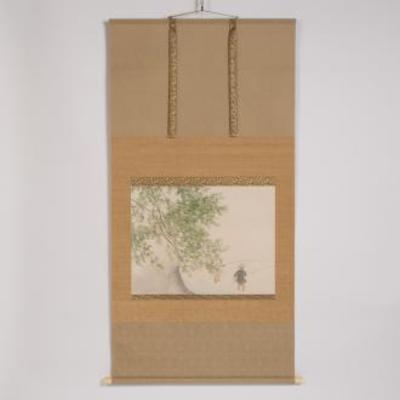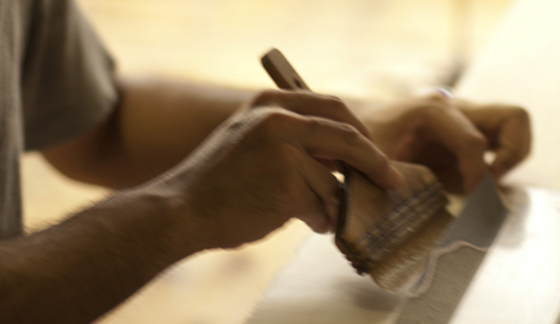
- Other crafts
- Tokyo
Edo Hyogu (Art Mountings) Edo Hyogu
Enhancing calligraphic works and paintings
Fine artwork spread with the development of the Edo merchant culture
Description
What is Edo Hyogu (Art Mountings) ?
Hyougu (art mountings) are used to set up calligraphic works and paintings into hanging scrolls, picture frames, and folding screens etc. for display and preservation. There are various types of art mountings such as hanging scrolls and scrolls, folding screens, picture frames and fusuma sliding doors. We are able to see calligraphic works and paintings that are hundreds of years old preserved beautifully, thanks to the the art mounting techniques. They have an important role to enhance and preserve the artwork. The material traditionally used for art mounting are fabric, mounting paper, lining paper, surface paper, backing paper, ribbing and frames, and starch paste. The fabric called kireji is especially important, as the total image of the artwork depends on the selection of the fabric. The Edo Hyogu hanging scrolls are generally short with simple, light colors. When the craftsman receives an order from the calligrapher or painter, he intuitively makes a plan of the combination of colors and patterns. He carefully selects the other material that are suitable to enhance the artwork. In recent years, as Japanese style rooms with tatami are decreasing with the change of architectural styles of houses, there are new styles of art mountings that match with western style rooms.
History

Art mounting techniques are said to have been introduced to Japan from China as Buddhist Scripture mounting techniques together with Buddhism. These techniques in Japan first developed in Kyoto where there were many temples and shrines and thus much demand for art mounting of the Buddhist Scripture and Buddhist paintings. At that time in Kyoto, the artisans were often called kyoji, meaning "Buddhist Scripture and Buddhist painting mounter", but with the change of the times, their work became diverse. Art mounting is also deeply related to the rise of prosperity of the tea ceremony. As art mountings were considered as a utensil for the tea ceremony, Japanese art mountings developed in its own unique way. Art mountings in Edo (current Tokyo) increased in the beginning of the Edo period (1603 – 1868). With the Sankin-kotai system where the daimyo (lords of the feudal domains) were required to reside in Edo in alternate years, extension work of their Edo residences increased, and artisans from the feudal domains came to Edo with the feudal lords, which resulted in the development of the merchant culture. Calligraphic works and paintings became popular among the general public, and the Edo Hyogu culture flourished.
General Production Process

- *Procedure for making hanging scrolls
- 1. Selection of material Material to enhance the artwork (calligraphic work or painting) is selected.
- 2. First layer of mounting material (Hadaurauchi)
The first layer of mounting material is applied on the back of the artwork and cloth for reinforcement.
- 3. Second mounting layer (Mashiurauchi) The second mounting layer is applied to make the thickness uniform and to provide firmness and resilience.
- 4. Final Mounting Layer (Ageurauchi) A brush called nadebake is used to brush the pieces of mounting material into place, followed by pounding with a brush called uchibake, and finally it is thoroughly brushed again.
- 5. Trimming and pasting The mounting material is trimmed and adhesive paste is applied. The elements are then pasted with the calligraphic work or painting placed in the middle.
- 6. Finishing Accessories such as the shaft and straps etc. are attached, and the hanging scroll is complete.
Where to Buy & More Information
Edo Hyogu Museum (Kyoshindo Inasaki Hyogu Store)
-
Address
-
Tel.+81-3-3666-6494
-
ClosedSundays, holidays and around the New Year
-
Business Hours9am to 6pm
-
Website
Edo Hyogu Museum (Maekawa Hyogu Store)
-
Address
-
Tel.+81-3-3631-0508
-
ClosedIrregular holidays, late November to mid-January
-
Business Hours10am to 4pm
See more Other crafts
- Edo kiriko cut glass
- Koshu lacquered deer leather
- Kyo folding fans
- Marugame uchiwa fans
- Boshu uchiwa fans
- Gifu lanterns
- Yamaga lanterns
- Kyo uchiwa fans
- Tendo Japanese chess pieces
- Edo glass
- Edo patterned paper
- Yame lanterns
- Owari Cloisonné
- Fukuyama Koto (Japanese Harp)
- Kyo art preservation
- Banshu fly-fishing flies
- Woodblock prints
- Koshu hand-carved seals
- Edo Hyogu (Art Mountings)
- Edo tortoise shell crafts
- Etchu Fukuoka Sedge Hats
- Gifu Japanese Umbrellas
- Nagasaki tortoise shell crafts
- Nagoya Sekku Kazari
- Sanshin
- Tokyo Koto (Japanese Harp)
- Tokyo Shamisen
See items made in Tokyo
- Edo kiriko cut glass
- Edo wood joinery
- Edo glass
- Murayama-oshima tsumugi silk
- Tokyo silverware
- Edo patterned paper
- Tokyo fine-patterned dyeing
- Edo bamboo fishing rods
- Tama brocade
- Hachio island silk
- Woodblock prints
- Tokyo textiles
- Edo-sekku doll
- Edo Hyogu (Art Mountings)
- Edo Oshi-e Pictures on Embossed Fabric
- Edo tortoise shell crafts
- Tokyo Honzome Chusen
- Tokyo Koto (Japanese Harp)
- Tokyo Plain Dyeing
- Tokyo Shamisen
- Tokyo antimony craft































































































































































































































































































